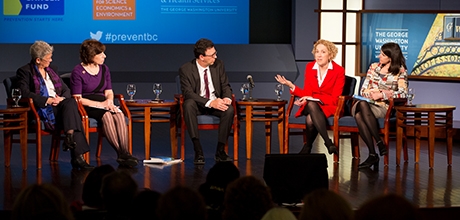There’s a new agenda on the breast cancer front. It’s preventing the disease altogether—particularly by looking to the environmental hazards that may be causing it.
That was the consensus of a panel of experts who participated Feb. 14 in a discussion at the George Washington University’s Jack Morton Auditorium co-hosted by the School of Public Health and Health Services.
“While advances in detection and treatment are incredibly important, in public health, we like to emphasize prevention,” said Lynn R. Goldman, dean of SPHHS. “In order to prevent breast cancer, we first need to understand what causes breast cancer.”
Experts working to do just that last week included: Linda Birnbaum, director of the National Institute of Environmental Health Sciences; Conn Nugent, president of the Heinz Center; Jeanne Rizzo, president and CEO of the Breast Cancer Fund; Florence Williams, author of “Breasts: A Natural and Unnatural History”; and Dr. Goldman. Frank Sesno, director of the School of Media and Public Affairs, moderated.
The statistics on breast cancer are sobering: It will strike more than 230,000 women this year—and likely cause 40,000 deaths, accounting for roughly 14 percent of all cancer deaths.
Experts examined environmental hazards, citing the findings of a recently released report from the National Institute of Health’s Interagency Breast Cancer and Environmental Research Coordinating Committee.
Factors like radiation exposure; alcohol consumption; obesity; and exposure to certain chemicals, such as bisphenol A (found in some food packaging and plastic) and phthalates (endocrine-disrupting chemicals found in some nail polishes and fragrances); all may increase your risk for breast cancer, experts said. But researchers aren’t just looking at risk factors. They’re also looking at when they may do the most harm. “Windows of susceptibility”—including during puberty, pregnancy, menopause and other times when the body is changing most—are “the time damage is most likely to occur,” Dr. Birnbaum said.
“We’ve got to stop talking about, is it genes or is it environment, because it’s always going to be both,” Dr. Birnbaum said. “You can’t change your genes, but you can change your environment.”
So who’s responsible for preventing breast cancer?
“I think it’s everyone,” Dr. Goldman said.
Panelists agreed. Government, industry and consumers all have a role to play, from government oversight and new policy to consumers being smarter about the choices they make, they said.
Moving forward, Dr. Birnbaum said her institute will continue to prioritize research that examines environmental factors and windows of susceptibility. Working on how to translate that knowledge into action will also be important, Ms. Rizzo said.
“We really all need to work together to prevent breast cancer,” Dr. Birnbaum said.


